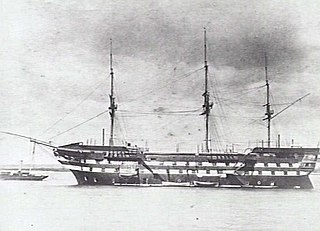
HMS Albion was a 74-gun third-rate ship of the line of the Royal Navy. She was launched at Perry's Blackwall Yard on the Thames on 17 June 1802. She was broken up at Chatham Dockyard in 1836.

HMS Queen was a 110-gun first-rate ship of the line of the Royal Navy, launched on 15 May 1839 at Portsmouth. She was the last purely sailing built battleship to be ordered. Subsequent ones were ordered with both sails and steam engines. All British battleships were constructed with sailing rig until the 1870s. HMS Queen had an auxiliary steam engine fitted in late 1850s. She was broken up in 1871.

HMS Royal Oak was a 74-gun third-rate ship of the line of the Royal Navy, built by Jonas Shish at Deptford and launched in 1674. She was one of only three Royal Navy ships to be equipped with the Rupertinoe naval gun. Life aboard her when cruising in the Mediterranean Sea in 1679 is described in the diary of Henry Teonge.

HMS St Lawrence was a 102-gun first-rate wooden warship of the Royal Navy that served on Lake Ontario during the War of 1812. Built on the lake at the Royal Navy dockyard in Kingston, Ontario, she was the only Royal Navy ship of the line ever to be launched and operated entirely in fresh water. Constructed in 1814, the ship's arrival on the lake ended all naval action and St Lawrence finished the war having never gone into battle. Following the war, the vessel was laid up, eventually being sold in 1832 to private interests. The ship was later sunk and is now a recreational dive spot.

Sir Thomas Slade was an English naval architect best known for designing the Royal Navy warship HMS Victory, which served as Lord Nelson's flagship at the Battle of Trafalgar in 1805.

HMS Indus was an 80-gun two-deck second-rate ship of the line of the Royal Navy, launched on 16 March 1839 at Portsmouth Dockyard.
The Endymion class was a class of six Royal Navy 40-gun fifth-rate frigates, with the prototype launched in 1797 and five slightly amended versions built of fir launched from 1813 to 1814.

The Ramillies-class ships of the line were a class of nine 74-gun third rates, designed for the Royal Navy by Sir Thomas Slade.

HMS Windsor Castle was a triple-decker, 102-gun first-rate Royal Navy ship of the line. She was renamed HMS Cambridge in 1869, when she replaced a ship of the same name as gunnery ship off Plymouth.
HMS Rupert was a 64-gun third rate ship of the line of the Royal Navy, ordered on 26 October 1664 as part of the ship construction programme of that year. She was launched on 26 January 1666 at Harwich Dockyard.

HMS Windsor was a 60-gun fourth rate ship of the line of the Royal Navy, launched at Deptford on 31 October 1695.

HMS Cumberland was a three-deck 80-gun third rate ship of the line of the Royal Navy, built by Joseph Allin the elder at Deptford Dockyard and launched on 27 December 1710. Her design corresponded to that laid down by the 1706 Establishment of dimensions for 80-gun ships.
HMS Falmouth was a 50-gun fourth-rate ship of the line built for the Royal Navy in the first decade of the 18th century. The ship participated in several battles during the War of the Spanish Succession (1701–15) and the War of Jenkins' Ear (1739–48).
The 1719 Establishment was a set of mandatory requirements governing the construction of all Royal Navy warships capable of carrying more than 20 naval long guns. It was designed to bring economies of scale through uniform vessel design, and ensure a degree of certainty about vessel capability once at sea, and was applied to all vessels from the first-rate to the fifth-rate. Once in effect, it superseded the 1706 Establishment, which had specified major dimensions for ships of the second-rate, third-rate and fourth-rate only.
HMS Burford was a 70-gun third rate ship of the line of the Royal Navy, built at Chatham Dockyard to the draught specified by the 1745 Establishment as amended in 1754, and launched in 1757.

The Conqueror-class ships of the line were a class of two 101-gun first rate screw propelled ships designed by the Surveyor’s Department for the Royal Navy.

HMS Victory is a 104-gun first-rate ship of the line of the Royal Navy. She was ordered in 1758, laid down in 1759, and launched in 1765. With 245 years of service as of 2023, she is the world's oldest naval vessel still in commission.

HMS Frederick William was an 86-gun screw-propelled first-rate ship of the line of the Royal Navy.
Two ships of the Royal Navy built at Portsmouth Royal Dockyard were intended to be HMS Royal Frederick, but renamed before being launched:

The Wolfe-class ship of the line was a 112-gun first-rate ship of the line class of two ships of the Royal Navy. The class was ordered during the arms race on the Great Lakes during the War of 1812 between Britain and America. Built at Kingston Royal Naval Dockyard, the ships were similar in design to their predecessor on Lake Ontario, the 102-gun HMS St Lawrence, but also included a quarterdeck or poopdeck. The two ships of the class, Wolfe and Canada, were laid down towards the end of 1814 but had not been completed when the war ended in the following year. Construction was suspended and the ship frames were left at the dockyard until 1831 and 1832 respectively when they were cancelled.














